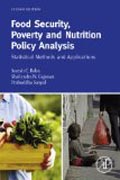
Food Security, Poverty and Nutrition Policy Analysis: Statistical Methods and Applications
Babu, K. Suresh
Gajanan, S.N.
Sanyal, Prabuddha
Food insecurity, the lack of access at all times to the food needed for an active and healthy life, continues to be a growing problem as populations increase while the world economy struggles. Formulating effective policies for addressing these issues requires thorough understanding of the empirical data and application of appropriate measurement and analysis of that information. Food Security, Poverty and Nutrition Policy Analysis, 2nd edition has been revised and updated to include hands-on examples and real-world case studies using the latest datasets, tools and methods. Providing a proven framework for developing applied policy analysis skills, this book is based on over 30 years of food and nutrition policy research at the International Food Policy Research Institute and has been used worldwide to impart the combined skills of statistical data analysis, computer literacy and their use in developing policy alternatives.This book provides core information in a format that provides not only the concept behind the method, but real-world applications giving the reader valuable, practical knowledge. Updated to address the latest datasets and tools, including STATA software, the future of policy analysisIncludes a new chapter on program evaluation taking the reader from data analysis to policy development to post-implementation measurementIdentifies the proper analysis method, its application to available data and its importance in policy development using real-world scenariosOver 30% new content and fully revised throughout INDICE: Preface to the Second Edition Introduction Section I: Food Security Policy Analysis Chapter 1: Introduction to food security: concepts and measurement Chapter 2. Implications of technological change, post-harvest technology and technology adoption for improved food security - application of t-statistic Chapter 3. Effects of commercialization of agriculture (shift from traditional crop to cash crop) on food consumption and nutrition - application of chi-square statistic Chapter 4. Effects of technology adoption and gender of household head: The issue, its importance in food security - application of Cramer's V and phi coefficient Chapter 5. Changes in food consumption patterns: its importance to food security - application of one-way ANOVA Chapter 6. Impact of market access on food security - application of factor analysis Section II: Nutrition Policy Analysis Chapter 7. Impact of maternal education and care on preschoolers' nutrition - application of two-way ANOVA Chapter 8. Indicators and causal factors of nutrition - application of correlation analysis Chapter 9. Effects of individual, household and community indicators on child's nutritional status - application of simple linear regression Chapter 10. Maternal education and community characteristics as indicators of nutritional status of children - application of multivariate regression Section III: Special Topics on Poverty, Nutrition and Food Policy Analysis Chapter 11. Predicting child nutritional status using related socioeconomic variables - application of discriminant function analysis Chapter 12. Measurement and determinants of poverty - application of logistic regression models Chapter 13. Classifying households on food security and poverty dimensions - application of K-mean cluster analysis Chapter 14. Household care as a determinant of nutritional status - application of instrumental variable estimation Chapter 15: Achieving an ideal diet - modeling with linear programming Chapter 16. Food and Nutrition Program Evaluation References Appendix Statistical tables
- ISBN: 978-0-12-405864-4
- Editorial: Academic Press
- Encuadernacion: Cartoné
- Páginas: 528
- Fecha Publicación: 15/03/2014
- Nº Volúmenes: 1
- Idioma: Inglés
